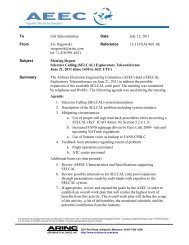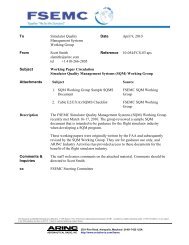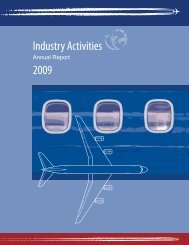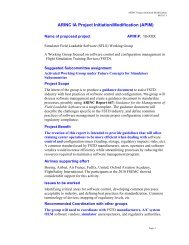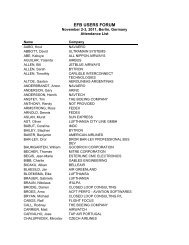(AGIE) Using Internet Protocols - Aviation Committees - AEEC - AMC
(AGIE) Using Internet Protocols - Aviation Committees - AEEC - AMC
(AGIE) Using Internet Protocols - Aviation Committees - AEEC - AMC
- No tags were found...
Create successful ePaper yourself
Turn your PDF publications into a flip-book with our unique Google optimized e-Paper software.
ARINC PROJECT PAPER 830 – Page 233.0 <strong>AGIE</strong> OVERVIEWor IP address of the destination, see Section 4.5. <strong>AGIE</strong> centrally maintainsdatabases containing the following information for the entire <strong>AGIE</strong> system:1. List of all defined <strong>AGIE</strong> clients2. List of all defined <strong>AGIE</strong> servers3. List of current associations between clients and servers4. List of current connections (paths) between servers.To assure that all <strong>AGIE</strong> nodes have access to this data, <strong>AGIE</strong> uses a ground basedsystem to host Primary functions including <strong>AGIE</strong> name services and hosting allcoordination databases.Every client has a ground-based “Home” server. All air-ground and ground-groundexchanges are routed through the client’s home to the final destination. While thisindirection adds latency, it reduces complexity and overhead and there is still only asingle air-ground exchange.It is, however, not efficient for client-to-client data exchange within the same aircraftto require routing messages through the Home server. Therefore, an onboard <strong>AGIE</strong>server acts as a “local Primary” server and supports direct onboard routing. It alsoacts as a local “Temporary Client Home” server when there is no access to theground-based client’s Home, providing store-and-forward capabilities todisconnected <strong>AGIE</strong> sub-networks. <strong>AGIE</strong> naming and addressing is further defined inSection 4.5.3.6.5 <strong>AGIE</strong> Data Delivery Management<strong>AGIE</strong> implements “store and forward” and “direct delivery” methods. All end-systemmessages are sent strictly from one client to another client with no exception.Internally, <strong>AGIE</strong> sends data to specific servers or functions, but clients are not setup or even allowed to do this. To initiate a transfer of data to a destination client, theoriginator client sends an XML document as a message to its host using a messageservice interface. The host processes the message and forwards it to the destination(or home). It may be necessary to locally store the information along the way until itreaches the destination, see Section 4.6.<strong>AGIE</strong> defines two end message servers. An “Origination server” receives themessage from its client. A “Destination server” delivers the message to thedestination client. While actual data paths may consist of multiple physical “hops,”only the origination and the destination servers are of relevance to the end clientsfor an <strong>AGIE</strong> data transfer. Both servers may be the same <strong>AGIE</strong> server.Data transfer between those two servers is managed via standard IP protocol usingAMQP in conjunction with any other aircraft/ground link IP routing service (e.g.,MAGIC).<strong>AGIE</strong> defines two principal classes of messages.User messages used to transfer end-system application related databetween <strong>AGIE</strong> clients.Coordination messages used to communicate any internal systemmanagement related information such as notifications, status enquires,connection coordination etc.Each message includes a unique identifier which is a combination of the senderidentifier plus an integer number, unique to the server, from which the message



